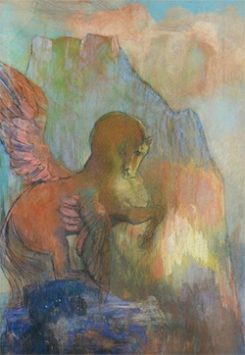
Pegasus, c. 1895-1900
Odilon Redon
Pegasus (Pégase), c. 1895-1900
Pastel on paper
67.4 x 48.7 cm
“As for me, I believe I have made an art that is expressive, suggestive, undetermined. An art that suggests is the irradiation of divine plastic elements brought together, combined in order to call forth dreams that it illuminates, exalts and incites to thought.”[1]
Bertrand-Jean Redon, better known as Odilon Redon (France, 1840-1916), took his nickname, “Odilon,” from his mother’s name: Odile. Due to poor health, he spent his childhood separated from his family in an isolated country home. The sense of melancholy and mystery Redon felt in the solitary landscape of his youth marked his entire oeuvre. This experience spurred him to delve into the realm of the imaginary, creating allusive and haunting art.[2]
For around 25 years Redon worked exclusively in black and white, first drawing in charcoal and then printmaking.[3] His charcoals and lithographs, suffused with a dramatic interplay of dark and light, were often defined by a somber, even macabre, mood.[4]
Redon was associated with Symbolism, a movement that rejected the imitation of nature in art in favor of the subjective and the mystical.[5] His works depicted fantastical and suggestive scenes.[6] Redon mined multiple sources for inspiration, including anthropology, microbiology, Eastern religions, the Bible, fictional literature, and Greek mythology. Yet his works maintained a universal spiritual significance, aspiring to pursue enlightenment in a world distressed by conflicting religious beliefs and scientific theories.[7]
Contrary to the Neo-Impressionist artists of his time, whose shimmering interpretations of city, suburb, or countryside reflected idealized places of harmony, Redon and most Symbolist artists reacted more pointedly to the malaise of contemporary life. They mistrusted scientific and pragmatic claims to ameliorate society, which had failed to alleviate social unrest and poverty, overcrowded urban cities, and the industrially polluted environment. They turned, instead, to alternative conceptions of spirituality, traditional religion, otherworldly themes, and interior states of mind.
During the early 1890s, after undergoing a religious crisis and a serious illness, Redon moved away from the unhappiness that had pervaded his early life to a more positive mindset. This, in part, impacted his adoption of radiant color and more joyful imagery.[8] A body of this work was exhibited in 1899 in a large Symbolist show at the famous Gallery Durand-Ruel. After the success of that presentation he started to exhibit his work more frequently.[9] Never before had he enjoyed such exposure. Notwithstanding, he continued to be more popular with artists than with critics and his core audience remained small.
For the rest of his career Redon used pastels and oil paints to generate colorful images, dispensing with charcoal and dark prints, for the most part. His work in pastel, a medium which enjoyed something of a revival at the end of the century, enabled him to retain some of the graphic effects of his lithographic efforts while experimenting with high key hues.
In addition, Redon’s subject matter shifted in tenor. He gradually turned his nightmares and monsters into mythological goddesses, magical creatures, and floral motifs, employing blurred contours and luminous areas of color. He rendered his subjects immaterial, evoking idealized visions that were lyrical and mystical.
The winged horse of Greek myth, was a leit-motif in Redon’s oeuvre. Pegasus was immortal, sired by the Greek god of the seas Poseidon. He was born from the decapitated Medusa, a monster in female form with a head of snakes who could turn people to stone if they looked at her. She was killed by the hero Perseus. Pegasus represents artistic inspiration and purity, which appealed to Redon in his quest for unfettered creativity.
[1] Redon, July 1909, in Odilon Redon, To Myself: Notes on Life, Art, and Artists, trans. Mira Jacob and Jeanne L. Wasserman (George Braziller, Inc. 1986), 96.
[2] Vivien Greene, ed., Paris, Fin de Siècle: Signac, Redon, Toulouse-Lautrec, and Their Contemporaries exh. cat. (Bilbao: Guggenheim Museum Bilbao, 2017), insert page number.
[3] https://www.ft.com/content/987ba5b8-c4e3-11de-8d54-00144feab49a
[4] Vivien Greene, ed., Paris, Fin de Siècle: Signac, Redon, Toulouse-Lautrec, and Their Contemporaries exh. cat. (Bilbao: Guggenheim Museum Bilbao, 2017), insert page number.
[5] Vivien Greene, ed., Paris, Fin de Siècle: Signac, Redon, Toulouse-Lautrec, and Their Contemporaries exh. cat. (Bilbao: Guggenheim Museum Bilbao, 2017), insert page number.
[6] https://www.artsy.net/artwork/odilon-redon-pegasus-and-the-hydra
[7] exhibition catalogue
[8] https://artuk.org/discover/artists/redon-odilon-18401916
[9] Michael Wilson, Nature and Imagination. The Work of Odilon Redon (London: Phaidon Press, Oxford, 1978), 54-60
Preguntas
Describe this artwork in as much detail as possible. Include your observations about the subject as well as the technique. Where do you think Pegasus is? What is happening? If you could guess, what would happen next?
Sketch the artwork and with a partner discuss what you notice about the lines and shapes the artist used. Reflect on how Redon is able to create the illusion of depth in this artwork. Which part in the artwork seems closest to us? Which are furthest away? Do you think the technique he used is more similar to drawing or to paint? Justify your answer.
Until Redon was 50 years old his images were dark and eerie, but after a personal crisis and a successful exhibition, Redon’s disposition was buoyed and he expressed himself with radiant colors. Research some of Redon’s earlier works and compare them with Pegasus. What differences and similarities, if any, can you find? What emotions do the colors used in this painting evoke in you? How has the artist accomplished that?
